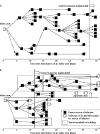Transmission potential of primary pneumonic plague: time inhomogeneous evaluation based on historical documents of the transmission network
- PMID: 16790838
- PMCID: PMC2566243
- DOI: 10.1136/jech.2005.042424
Transmission potential of primary pneumonic plague: time inhomogeneous evaluation based on historical documents of the transmission network
Abstract
Background: The transmission potential of primary pneumonic plague, caused by Yersinia pestis, is one of the key epidemiological determinants of a potential biological weapon, and requires clarification and time dependent interpretation.
Method: This study estimated the reproduction number and its time dependent change through investigations of outbreaks in Mukden, China (1946), and Madagascar (1957). Reconstruction of an epidemic tree, which shows who infected whom, from the observed dates of onset was performed using the serial interval. Furthermore, a likelihood based approach was used for the time inhomogeneous evaluation of the outbreaks for which there was scarcity of cases.
Results: According to the estimates, the basic reproduction number, R(0), was on the order of 2.8 to 3.5, which is higher than previous estimates. The lower 95% confidence intervals of R(0) exceeded unity. The effective reproduction number declined below unity after control measures were introduced in Mukden, and before the official implementation in Madagascar.
Conclusion: While the time course of the latter outbreak could be explained by intrinsic factors and stochasticity in this remote and scarcely populated area, the former in Mukden suggests the possible continued chains of transmission in highly populated areas. Using the proposed methods, the who infected whom information permitted the evaluation of the time inhomogeneous transmission potential in relation to public health measures. The study also tackles the problem of statistical estimation of R(0) based on similar information, which was previously performed simply by counting the number of secondary transmissions regardless of time.
Conflict of interest statement
Conflicts of interest: none.
Similar articles
-
Dynamics of the pneumonic plague epidemic in Madagascar, August to October 2017.Euro Surveill. 2017 Nov;22(46):17-00710. doi: 10.2807/1560-7917.ES.2017.22.46.17-00710. Euro Surveill. 2017. PMID: 29162211 Free PMC article.
-
The 2017 plague outbreak in Madagascar: Data descriptions and epidemic modelling.Epidemics. 2018 Dec;25:20-25. doi: 10.1016/j.epidem.2018.05.001. Epub 2018 Jun 2. Epidemics. 2018. PMID: 29866421
-
The rise of pneumonic plague in Madagascar: current plague outbreak breaks usual seasonal mould.J Med Microbiol. 2019 Mar;68(3):292-302. doi: 10.1099/jmm.0.000915. Epub 2019 Jan 11. J Med Microbiol. 2019. PMID: 30632956 Review.
-
Epidemiology of a primary pneumonic plague in Kantoshu, Manchuria, from 1910 to 1911: statistical analysis of individual records collected by the Japanese Empire.Int J Epidemiol. 2006 Aug;35(4):1059-65. doi: 10.1093/ije/dyl091. Epub 2006 May 9. Int J Epidemiol. 2006. PMID: 16684896
-
Risk of person-to-person transmission of pneumonic plague.Clin Infect Dis. 2005 Apr 15;40(8):1166-72. doi: 10.1086/428617. Epub 2005 Mar 16. Clin Infect Dis. 2005. PMID: 15791518 Review.
Cited by
-
A Methodology for Determining Which Diseases Warrant Care in a High-Level Containment Care Unit.Viruses. 2019 Aug 22;11(9):773. doi: 10.3390/v11090773. Viruses. 2019. PMID: 31443440 Free PMC article.
-
Dynamics of the pneumonic plague epidemic in Madagascar, August to October 2017.Euro Surveill. 2017 Nov;22(46):17-00710. doi: 10.2807/1560-7917.ES.2017.22.46.17-00710. Euro Surveill. 2017. PMID: 29162211 Free PMC article.
-
Estimation of Pneumonic Plague Transmission in Madagascar, August-November 2017.PLoS Curr. 2018 Nov 1;10:ecurrents.outbreaks.1d0c9c5c01de69dfbfff4316d772954f. doi: 10.1371/currents.outbreaks.1d0c9c5c01de69dfbfff4316d772954f. PLoS Curr. 2018. PMID: 30450266 Free PMC article.
-
Infectiousness of smallpox relative to disease age: estimates based on transmission network and incubation period.Epidemiol Infect. 2007 Oct;135(7):1145-50. doi: 10.1017/S0950268806007618. Epub 2006 Dec 7. Epidemiol Infect. 2007. PMID: 17156499 Free PMC article. Review.
-
Extracting key information from historical data to quantify the transmission dynamics of smallpox.Theor Biol Med Model. 2008 Aug 20;5:20. doi: 10.1186/1742-4682-5-20. Theor Biol Med Model. 2008. PMID: 18715509 Free PMC article. Review.
References
-
- Williams P, Wallace D.Unit 731: Japan's secret biological warfare in world war II. New York: The Free Press, 1989
-
- Harris S H.Factories of death. New York: Routledge, 1994
-
- Alibek K, Handelman S.Biohazard. New York: Random House, 1999
-
- McGovern T W, Friedlander A M. Plague. In: Siedell FR, Takafuji ET, Franz DR, et al, eds. Medical aspects of chemical and biological warfare. Washington, DC: Walter Reed Army Medical Center, 1997479–502.
Publication types
MeSH terms
LinkOut - more resources
Full Text Sources
Medical



